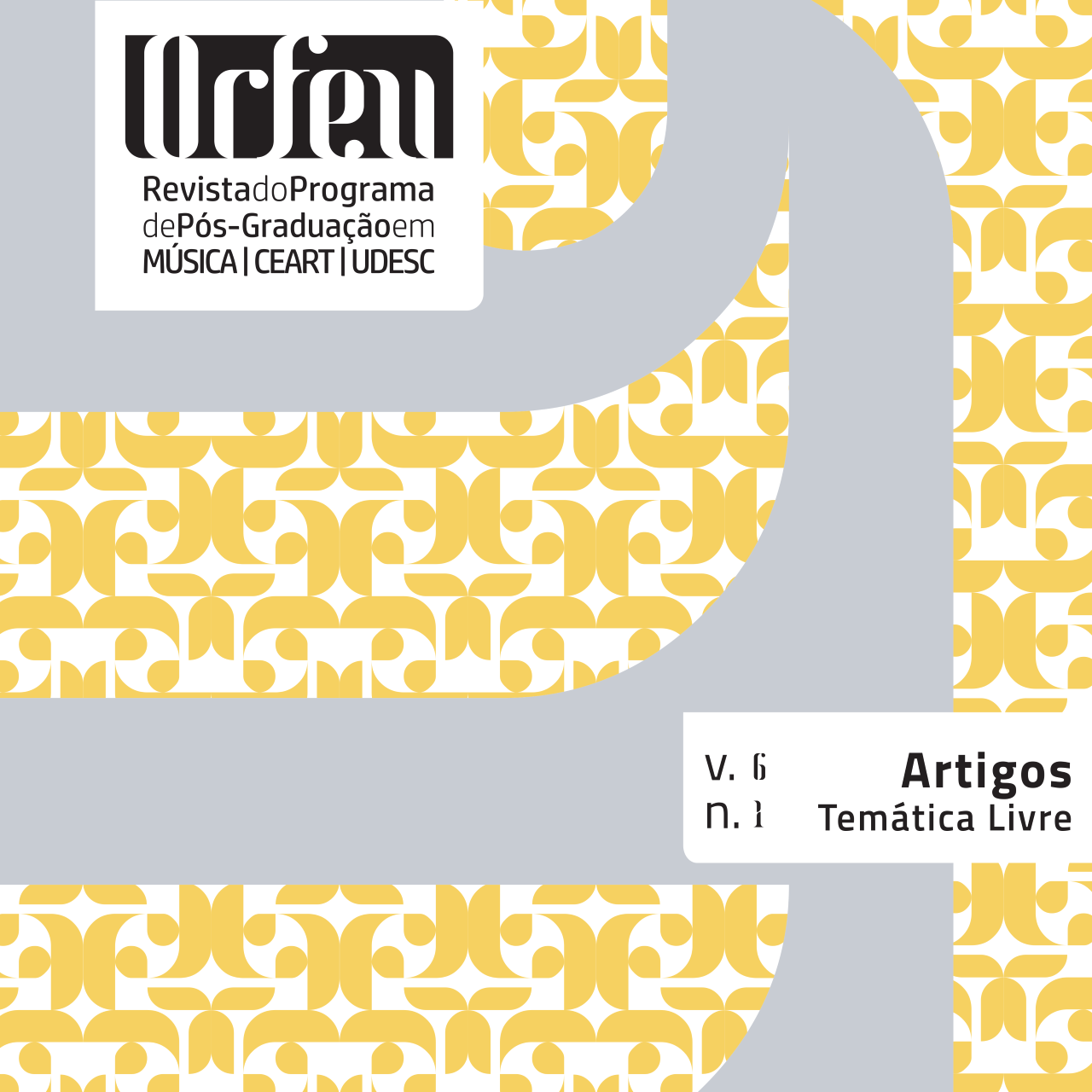Indícios de conhecimentos musicais nas concepções estilísticas preliminares de pianistas pós-graduandos: um estudo quase-experimental
DOI:
https://doi.org/10.5965/2525530406012021e0023Parole chiave:
conhecimento musical, estilo, prática musical, pianista, performanceAbstract
Este artigo tem por objetivo mapear indícios de conhecimentos musicais nas concepções preliminares de estilo demonstradas nas falas de jovens pianistas em nível de pós-graduação, na preparação de três obras impostas de períodos históricos distintos. Um quase-experimento foi realizado com três estudantes de piano cursando mestrado e doutorado em Música, em que os participantes aprenderam obras musicais de diferentes períodos (séc. XVIII, XIX e XX) e compositores (Haydn, Chopin e Bartók) em três sessões de estudo. Entrevistas e registros das obras pelos participantes permitiram coletar concepções para performances. Os resultados demonstraram consenso nas concepções sobre compositores e estilos em que os participantes já tinham experiência prévia de estudo de repertório (Haydn, Chopin), sendo que em Bartók, o consenso foi pequeno. A investigação trouxe evidências de que as referências relacionadas de modos de expressão musical prévios, organização explícita de entendimento (pré-concebido), assim como recepção/percepção na qualidade de intérprete-ouvinte parecem ser indícios consistentes de interconectar conhecimentos estilísticos e avançar perspectivas de conhecimento musical de instrumentistas em formação.
Downloads
Riferimenti bibliografici
BAE, A; PARK, D; PARK, J. The network of western classical musicians. 2014 Studies in Computational Intelligence 549, pp. 13-24.
BARONI, M. Style et mutations stylistiques dans la tradition musicale européenne. In: J. J. Nattiez (Org.) Musiques. Une encyclopédie pour le XXI e siècle. V. 4 – Histoires des musiques européenes. Paris: Actes de Sud (pp. 53-70), 2005.
BARTÓK, Bela. Fifteen Hungarian Peasant Songs: Old Dance Tunes n. 7. Vienna: Universal Edition, 1920, p.60.
CARRASCOSO, J.L.A. Teoría del conocimiento. Madrid: Síntesis, 1999.
CHOPIN, Frédéric. Mazurken: Op. 33 n. 3. G. Henle Verlag, 1975. Pp. 64, 65.
CLARKE, Eric F. Generative principles in music performance. In: SLOBODA, J. A. (Ed.) Generative processes in music: The psychology of performance, improvisation, and composition. Oxford: Clarendon, p. 1-26, 1989.
CONE, Edward T. The pianist as critic. The practice of performance: Studies in music interpretation. Edited by John Rink. Cambridge University Press, 1995. Pp. 241-253.
COPLAND, Aaron. A Nova Música. Tradução: Lívio Dantas. Gráfica Record Editora. Rio de Janeiro, 1969.
DAHLHAUS, Carl. Nineteenth-Century Music. English translation by J, Bradford Robinson. University of California Press, 1989.
DODSON, Alan. Expressive timing in expanded phrases: an empirical study of recordings of three Chopin preludes. Royal Northern College of Music Vol. 4 2-29, 2011.
ELLIOTT, David J. Music Matters. Oxford University Press. New York, 1995.
ELLIOTT, David; SILVERMAN, Marissa. Music Matters: A Philosophy of Music Education. (2nd Ed). New York: Oxford University Press, 2015.
ELLISON, S.; BARWICK, V.; FARRANT, T. Designing Effective Experiments. In: Practical Statistics for the analytical Scientist: A Bench Guide. 2 ed. LGC Limited, 2009. Cap. 8, p. 131-133.
GROVE MUSIC ONLINE. Oxford Music Online. Disponível em http://www.oxfordmusiconline.com/. Acesso em 08/10/2018.
HARNONCOURT, Nikolaus. O Discurso dos Sons. Caminhos para uma nova compreensão musical. Tradução: Marcelo Fagerlande. Jorge Zahar Editor. Rio de Janeiro, 1988.
HAYDN, Joseph. Complete Piano Sonatas, Volume I: Sonata Hob XVI n. 10, mov2. G. Henle Verlag, 1970, p. 86.
LÁSZLÓ, Ferenc. Béla Bartók and the Ideal of Europe – Lecture held at the Hungarian Institute in Bucharest on May the 3rd 2004 – Copyright of Central University Library “Lucian Blaga” in Cluj-Napoca. Pp. 46-51.
LARUE, Jan. Análisis del Estilo Musical. Pautas sobre la contribuición a la música del sonido, la armonía, el ritmo y el crecimiento formal. Editorial Labor S.A. Barcelona, 1989.
MEYER, Leonard B. Style and Music. Theory, History and Ideology. Originally published 1989 by the University of Pennsylvania Press in the series Studies in the Criticism and Theory of Music. The University of Chicago Press, 1996.
MONTEIRO, Heidi. Perspectivas de pianistas sobre expressividade em performance musical como intérpretes e ouvintes. Tese de Doutorado. Universidade Federal do Rio Grande do Sul. Instituto de Artes. Programa de Pós-Graduação em Música. Porto Alegre, 2019.
NISSMAN, Barbara. Bartók and the Piano. A Performer’s View. The Scarecrow Press, Inc. Lanham, Maryland, and Oxford 2002.
RITTERMAN, Janet. Piano music and the public concert 1800-1850. In The Cambridge Companion to Chopin. Edited by Jim Samsom. Cambridge University Press, 1992.
ROSEN, Charles. El Estilo Clásico. Haydn, Mozart, Beethoven. Versión española de Elena Giménez Moreno. Revisión de José María Martín Triana. Alianza Editorial, Madrid, 2003.
SONG, Moo Kyoung; KIM, You Jim. Speaking of your own repertoire: an investigation of music performance during practice. British Journal of Music Education (2020), 37, 260–269. Cambridge University Press.
SLOBODA, John Anthony. The music mind: the cognitive psychology of music. Oxford: Oxford University Press, 2000.
SWANWICK, Keith. Musical knowledge: intuition, and music education. London: Routledge, 1994.
SWANWICK, Keith. Ensinando Música Musicalmente. Tradução de Alda Oliveira e Cristina Tourinho. São Paulo. Moderna, 2003.
TIZÓN, Manuel; GÓMEZ-MARTÍN, Francisco. La influencia del estilo musical em la emoción percibida. Revista Electrónica Complutense de Investigación en Educación Musical. 17, 2020: 85-108.
WEIß, Christof; MAUCH Matthias; DIXON Simon; MÜLLER Meinard. Investigating Style Evolution of Western Classical Music: A Computational Approach. Musicae Scientiae 23, no. 4 (December 2019): 486–507.
Downloads
Pubblicato
Come citare
Fascicolo
Sezione
Licenza
Copyright (c) 2021 Regina Antunes Santos, Samuel Henrique Ciambroni

TQuesto lavoro è fornito con la licenza Creative Commons Attribuzione 4.0 Internazionale.






